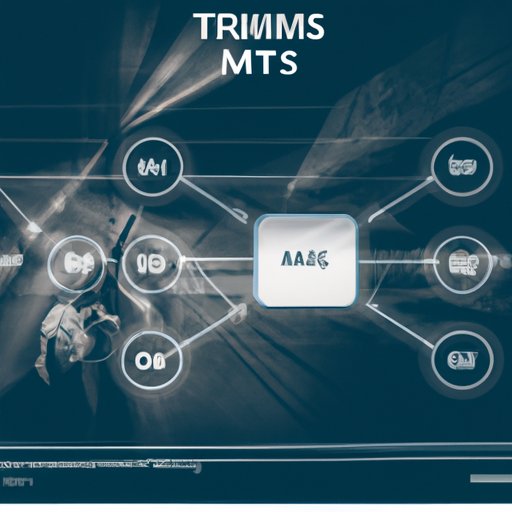Introduction
Transportation Management Systems (TMS) are software solutions designed to make transportation processes more efficient and cost-effective. This technology is used by businesses to streamline their shipping and logistics operations, allowing them to save time and money while increasing their visibility into the supply chain. In this article, we will explore what TMS technology is, how it works, and the benefits it can offer businesses.
What is TMS Technology?
TMS technology is a type of software that helps businesses manage their transportation and logistics operations. It enables companies to track shipments, optimize routes, and analyze data to identify areas for improvement. TMS technology can be used to automate processes such as order processing, freight rate calculation, route optimization, and carrier selection. Additionally, it can provide valuable insights into areas such as inventory levels, delivery times, and customer service.
How Does it Work?
TMS technology works by collecting data from various sources, such as carriers, warehouse systems, and customers. It then uses this data to create an automated workflow for managing transportation and logistics operations. Through this data-driven process, businesses can gain greater visibility into their supply chain, helping them to make informed decisions and reduce costs. Additionally, TMS technology can be used to integrate with other systems, such as ERP or WMS, to create a unified platform for managing all aspects of the supply chain.
Benefits of Using TMS Technology in Businesses
There are many benefits to using TMS technology in businesses. Here are some of the most notable:
Improved Efficiency
One of the main benefits of using TMS technology is that it can significantly improve the efficiency of transportation and logistics operations. By automating manual processes, such as order processing and route optimization, businesses can reduce the amount of time it takes to complete tasks. According to a study by the University of Tennessee, businesses that use TMS technology can save up to 20% in labor costs.
Increased Visibility
TMS technology can also provide businesses with greater visibility into their supply chain. With comprehensive reporting capabilities, businesses can quickly identify potential issues and take corrective action before they become costly problems. Additionally, businesses can use the data generated by TMS technology to gain insights into areas such as customer behavior, inventory levels, and delivery times.
Better Control of Costs
By using TMS technology, businesses can gain better control over their transportation and logistics costs. The software can help identify areas for improvement, such as reducing empty miles, optimizing routes, and selecting the best carriers. Additionally, TMS technology can be used to negotiate better rates with carriers, resulting in significant savings.
Different Types of TMS Technology Available
When it comes to choosing a TMS technology solution, there are several options available. Here are three of the most common:
Cloud-Based
Cloud-based TMS technology is a software-as-a-service (SaaS) model that allows businesses to access the system via the internet. This type of solution is typically hosted on the cloud, meaning businesses don’t have to purchase additional hardware or software. Additionally, cloud-based TMS technology is usually more affordable than on-premise solutions.
On-Premise
On-premise TMS technology is a traditional solution that requires businesses to install the software on their own servers. This type of solution offers businesses greater control over their data, but it can also be more expensive and complex to maintain. Additionally, on-premise solutions may require businesses to purchase additional hardware and software.
Software as a Service (SaaS)
Software as a service (SaaS) is a model where businesses pay a subscription fee to access the software. This type of solution is typically more affordable than on-premise solutions, and it doesn’t require businesses to purchase any additional hardware or software. Additionally, SaaS solutions are often easier to maintain than on-premise solutions.

Impact of TMS Technology on Supply Chain Management
TMS technology can have a significant impact on supply chain management. Here are some of the ways it can benefit businesses:
Streamlined Processes
TMS technology can streamline many of the processes involved in supply chain management, such as order processing, route optimization, and carrier selection. This can help businesses reduce costs and improve efficiency. Additionally, TMS technology can be used to automate many of the manual tasks associated with supply chain management, such as invoicing and tracking.
Improved Communication
TMS technology can also help improve communication between businesses and their suppliers and customers. By providing real-time updates on orders and shipments, businesses can ensure that everyone is on the same page. Additionally, TMS technology can be used to create reports that provide insight into areas such as delivery times and customer service.
Reduced Risk
Using TMS technology can also help businesses reduce the risk associated with their supply chain operations. With comprehensive reporting capabilities, businesses can quickly identify areas of concern and take corrective action before they become costly problems. Additionally, TMS technology can be used to monitor supplier performance, helping businesses ensure that their suppliers are meeting their standards.

Challenges and Risks Involved With Implementing TMS Technology
Although TMS technology can offer many benefits to businesses, there are also challenges and risks associated with its implementation. Here are some of the most notable:
Cost of Implementation
One of the biggest challenges associated with implementing TMS technology is the cost. Depending on the type of solution chosen, businesses may have to purchase additional hardware and software, which can be expensive. Additionally, businesses may need to hire additional personnel to manage the system, which can also add to the cost.
Complexity of Systems
Another challenge associated with implementing TMS technology is the complexity of the systems. Many of these solutions are highly technical and require extensive training. Additionally, businesses may need to invest in additional resources, such as consultants, to help them understand the system and get the most out of it.
Training Requirements
Finally, businesses may need to invest in training for their employees to ensure they know how to properly use the TMS technology. This can be costly and time-consuming, but it is necessary to ensure the system is used correctly and efficiently.
Cost-Effectiveness of Utilizing TMS Technology
Despite the challenges associated with implementing TMS technology, it can still be a cost-effective solution for businesses. Here are some of the ways businesses can save money by using TMS technology:
Short-Term Savings
One of the primary benefits of TMS technology is that it can help businesses save money in the short term. By automating processes such as order processing and route optimization, businesses can reduce labor costs and improve efficiency. Additionally, businesses can use TMS technology to negotiate better rates with carriers, resulting in significant savings.
Long-Term ROI
In addition to the short-term savings, businesses can also realize long-term returns on their investment in TMS technology. By gaining greater visibility into their supply chain, businesses can identify areas for improvement and take corrective action to reduce costs. Additionally, TMS technology can be used to create reports that provide valuable insights into areas such as customer behavior, delivery times, and inventory levels.

Future of TMS Technology in the Marketplace
The future of TMS technology is bright. As businesses continue to look for ways to improve the efficiency and cost-effectiveness of their transportation and logistics operations, TMS technology will continue to grow in popularity. Here are some of the ways TMS technology is likely to evolve in the coming years:
Growth Potential
As businesses become more aware of the benefits of TMS technology, the demand for these solutions is likely to continue to increase. According to a report by Grand View Research, the global TMS market is expected to reach $7.1 billion by 2025, representing a compound annual growth rate of 10.9%.
Adaptability to Changing Needs
TMS technology is also likely to become more adaptable to changing needs. As businesses’ requirements evolve, TMS technology will continue to evolve with them, providing more features and functionality to meet their needs. Additionally, new technologies such as artificial intelligence and machine learning are likely to be incorporated into TMS solutions, further enhancing their capabilities.
Expansion of Capabilities
Finally, the capabilities of TMS technology are likely to expand in the coming years. Companies are increasingly looking for solutions that can provide end-to-end visibility into their supply chains, and TMS technology is well-positioned to meet this demand. Additionally, companies are likely to look for ways to integrate TMS technology with other systems, such as ERP and WMS, to create a unified platform for managing all aspects of the supply chain.
Conclusion
TMS technology can be an invaluable tool for businesses looking to streamline their transportation and logistics operations. By automating processes and providing greater visibility into their supply chain, businesses can save time and money while improving efficiency. Although there are challenges and risks associated with implementing TMS technology, the benefits far outweigh the costs. As businesses continue to seek ways to reduce costs and improve efficiency, TMS technology will remain an essential part of the supply chain management process.
(Note: Is this article not meeting your expectations? Do you have knowledge or insights to share? Unlock new opportunities and expand your reach by joining our authors team. Click Registration to join us and share your expertise with our readers.)
